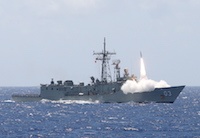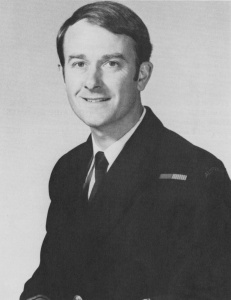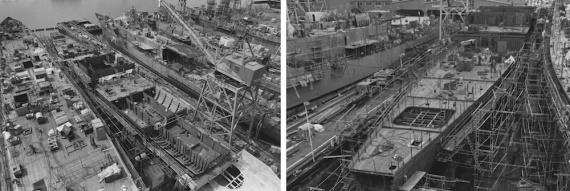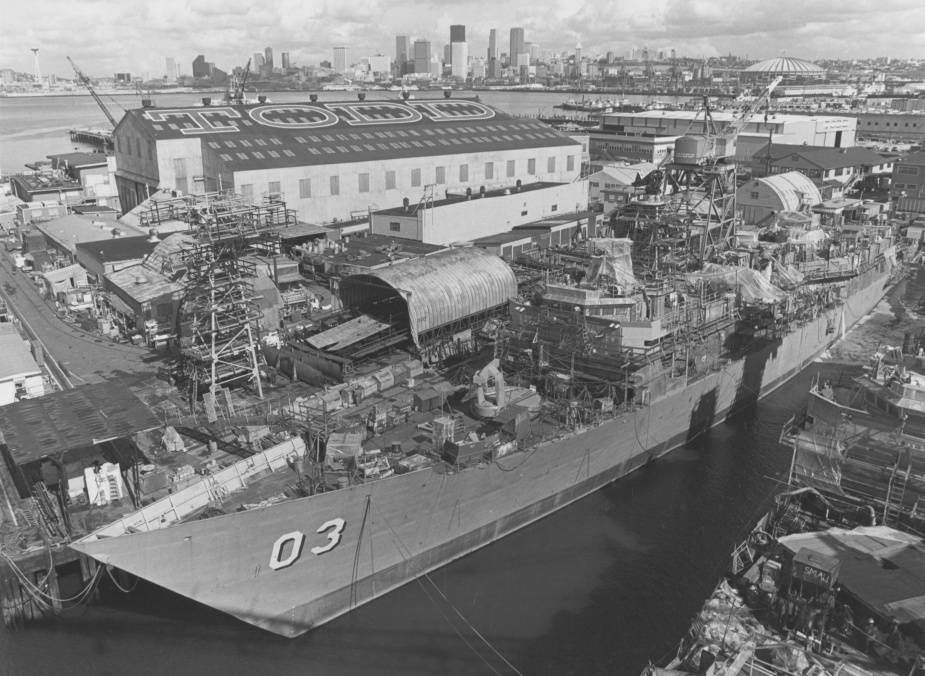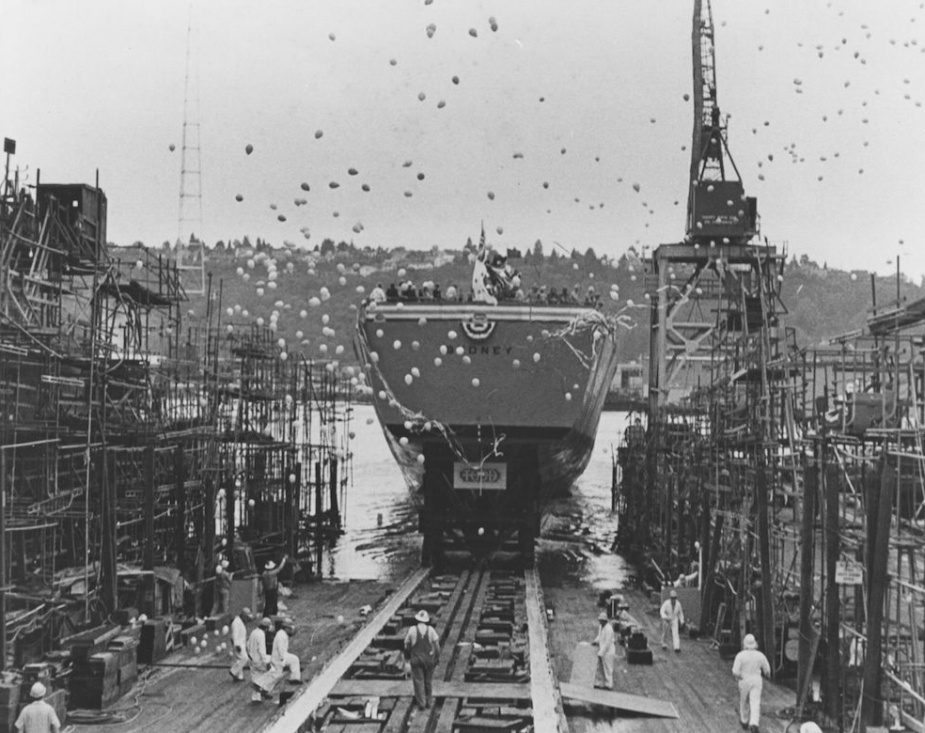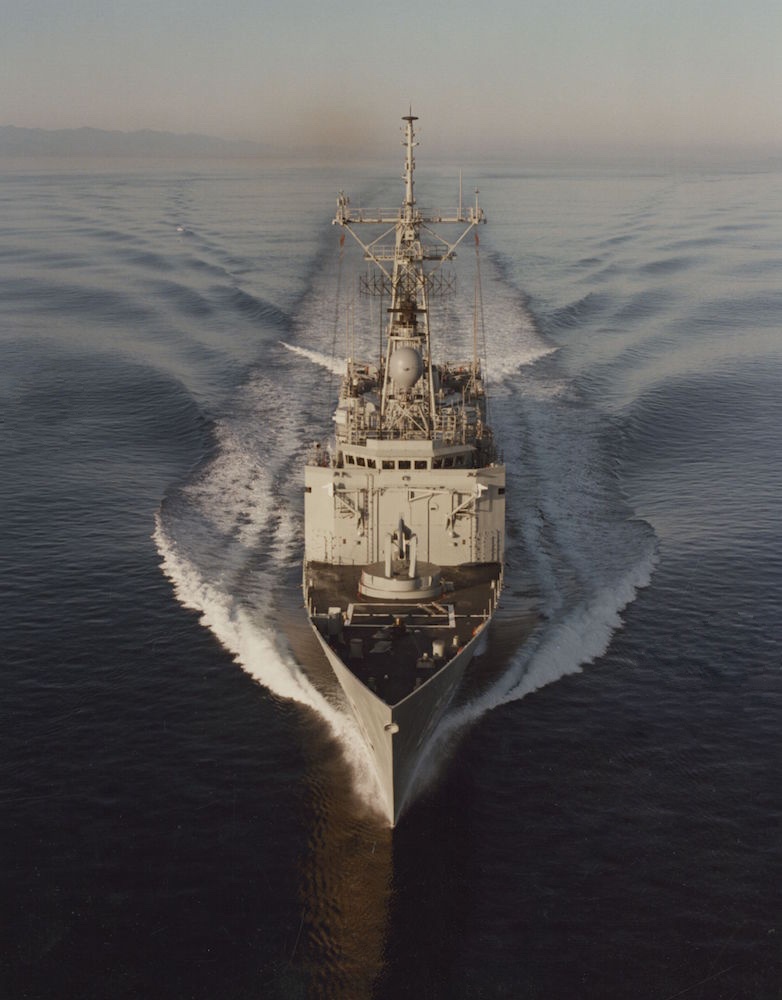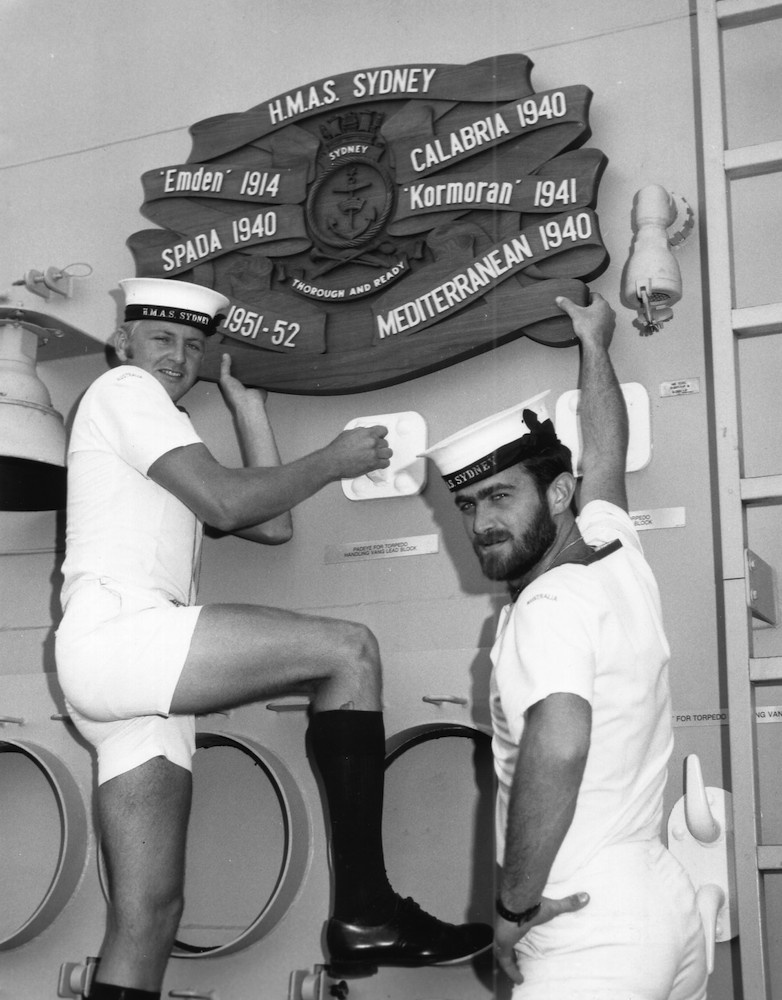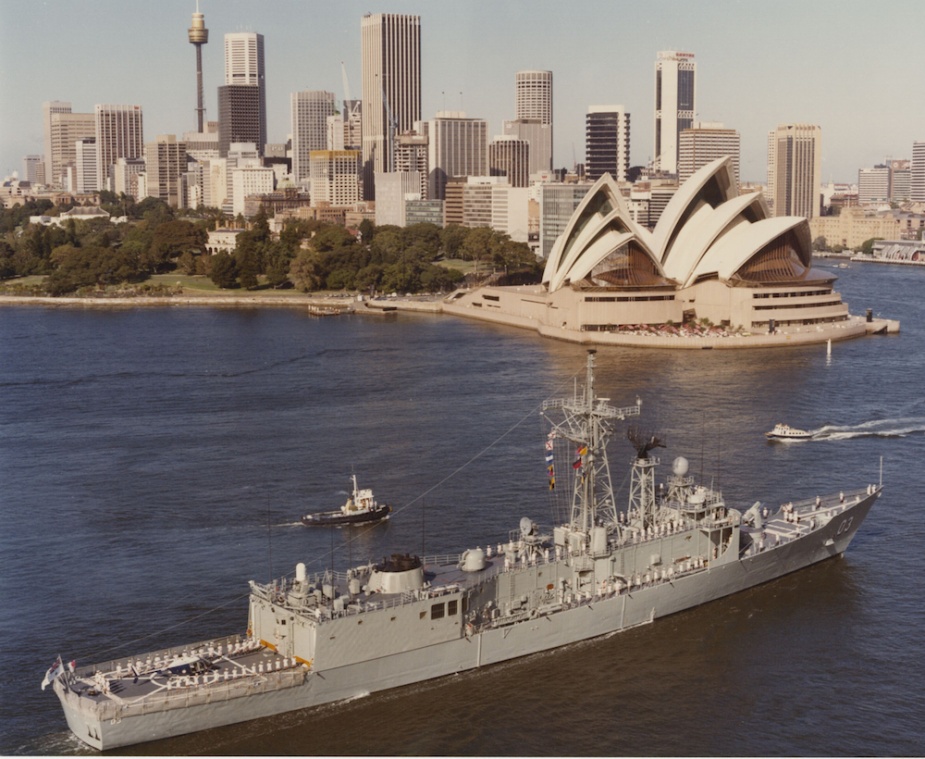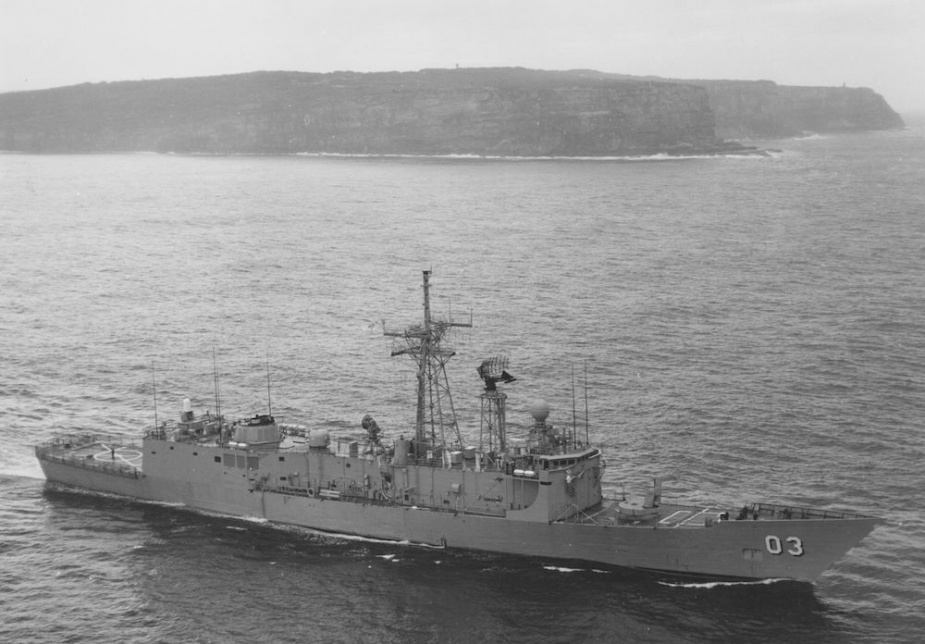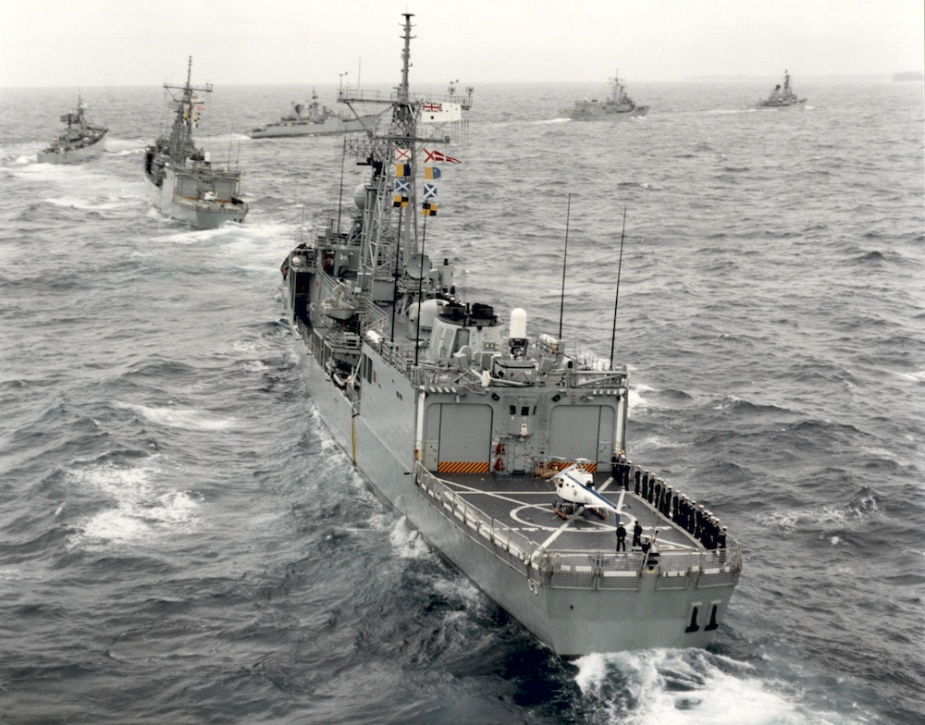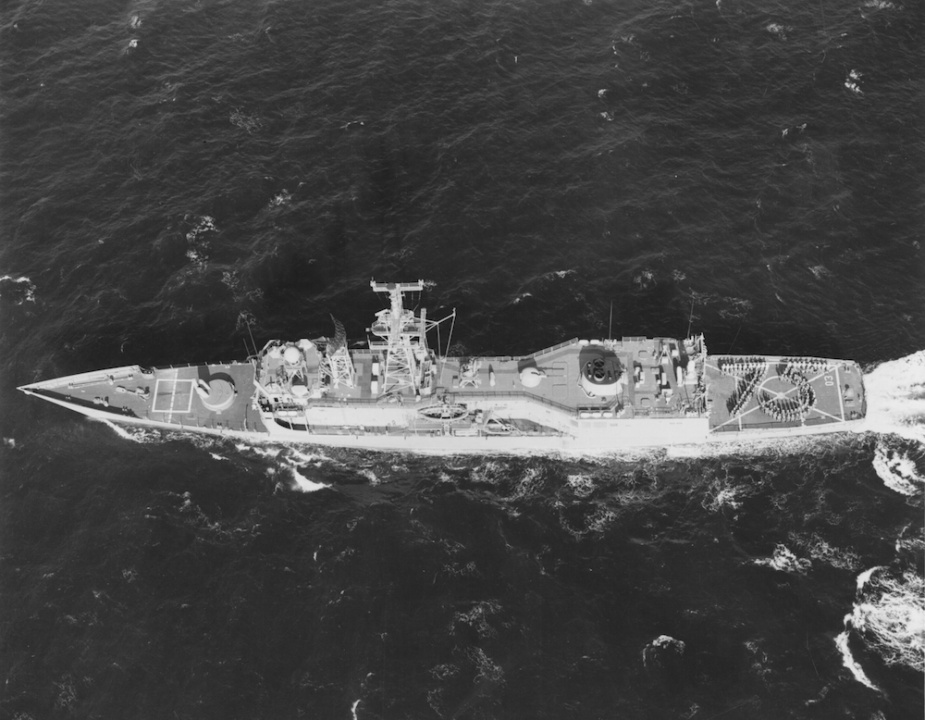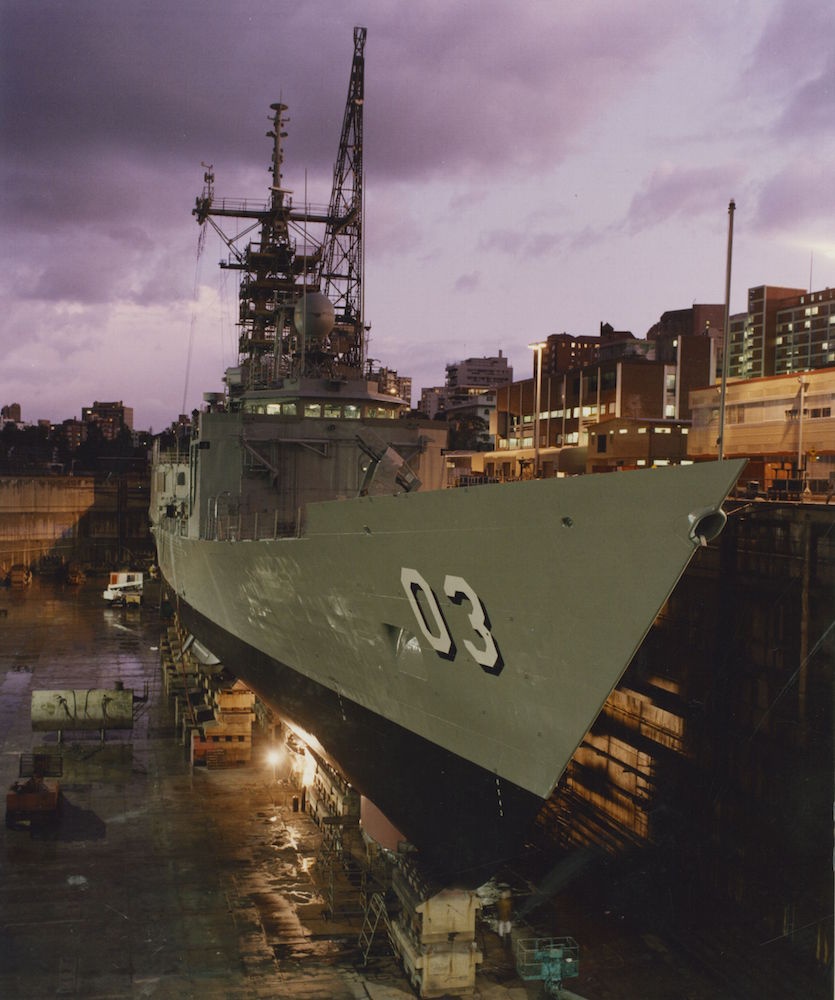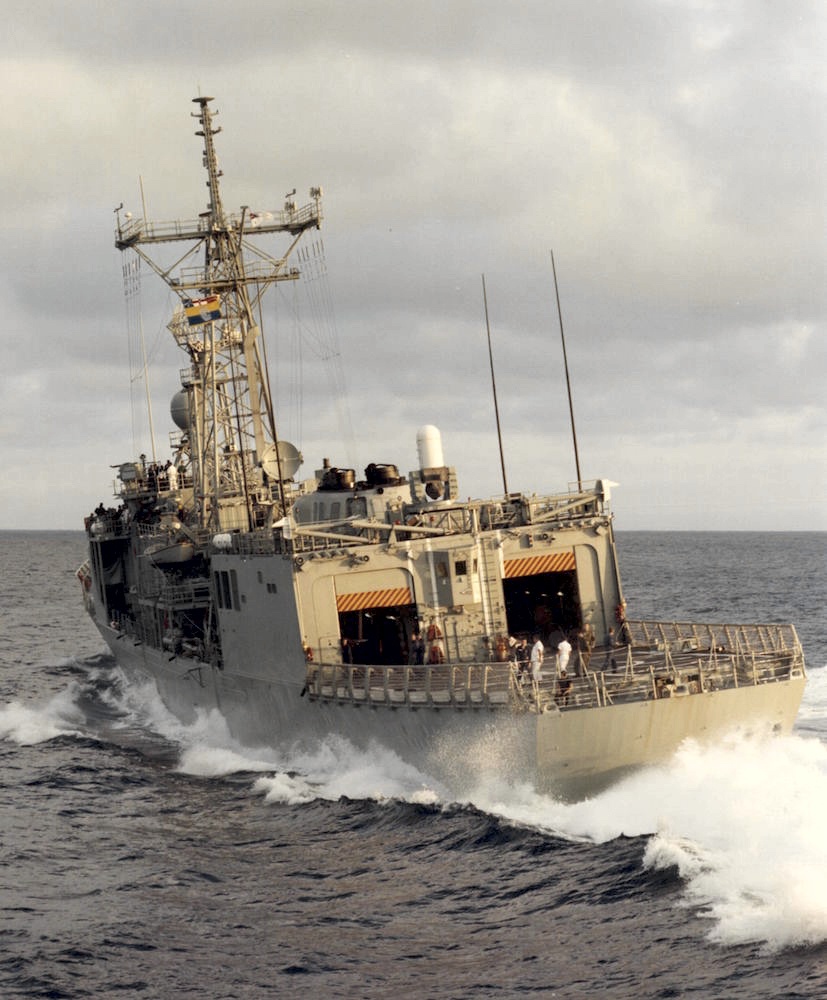HMAS Sydney (IV)
| Class |
Adelaide Class |
|---|---|
| Type |
Guided Missile Frigate (FFG) |
| Pennant |
03 |
| International Callsign |
VKML |
| Nickname |
'Steak 'n' Kidney' |
| Motto |
Thorough and Ready |
| Builder |
Todd Pacific Shipyard Corporation, Seattle |
| Launched |
26 September 1980 |
| Launched by |
Mrs Marjorie Joyce Willis |
| Commissioned |
29 January 1983 |
| Decommissioned |
7 November 2015 |
| Dimensions & Displacement | |
| Displacement | 4267 tonnes |
| Length | 138.1 metres |
| Beam | 13.7 metres |
| Draught | 4.5 metres |
| Performance | |
| Speed | 29 knots |
| Range | 4500 nautical miles |
| Complement | |
| Crew | 210 |
| Propulsion | |
| Machinery |
|
| Armament | |
| Missiles |
|
| Guns |
|
| Torpedoes | 6 x Mk 32 (2 triple) tubes |
| Helicopters |
|
| Awards | |
| Inherited Battle Honours | |
| Battle Honours | |
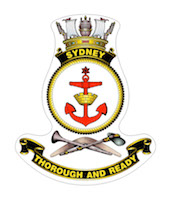
HMAS Sydney (IV) was the third of six Adelaide Class guided missile frigates (FFG) to commission into the Royal Australian Navy (RAN). She was built at the Todd Pacific Shipyards in Seattle, Washington, USA, and commissioned there on 29 January 1983 under the command of Commander Paul Kable, RAN. The first four FFGs, HMA Ships Adelaide (II), Canberra (II), Sydney and Darwin, were built in the USA with subsequent modifications undertaken in Australia. The last two, HMA Ships Melbourne (III) and Newcastle, were constructed in Australia with all modifications incorporated.
The Adelaide Class was based upon the US-designed Oliver Hazard Perry Class FFG, the concept for which began in 1971 when the United States Navy (USN) initiated a programme to build 50 patrol frigates. These were later redesignated guided missile frigates designed for long-range escort with roles including air defence, anti-submarine warfare, surveillance, interdiction and reconnaissance. They were capable of countering simultaneous threats from the air, surface and sub-surface. These ships were the first RAN ships to be powered by gas turbine for the main propulsion and could be underway from cold in less than 30 minutes. Two forward mounted, retractable auxiliary propulsion units provided a secondary means of propulsion plus excellent manoeuvrability in confined waters.
The decision to purchase the FFGs from the USA, and the consequent training programme required of their crews, led to the establishment of the RAN FFG Ashore Support Office to provide administrative support to the ships’ personnel and their dependents. The FFG Ashore Support Office began operations at the US Naval Station, Long Beach, California on 1 February 1980 and moved to Bellevue, Washington on 15 September 1982. The office performed a range of support tasks including salary and allowance payments, travel and accommodation arrangements, removals assistance and other personal services.
HMAS Sydney’s commissioning crew were in Seattle by 4 January 1983 and conducted intensive training and storing of the ship. The crew moved on board on 20 January and began preparations for the commissioning ceremony in spite of persistent rain. The ship commissioned on 29 January under a clear sky, the fourth RAN vessel to carry the name Sydney. During the ceremony, the Guest of Honour, the Lord Mayor of Sydney, the Right Honourable, Alderman Douglas Sutherland, AM, JP, reaffirmed Sydney’s right of Freedom of Entry to the City of Sydney.
The commissioning crews also received training and other practical support from the USN’s Fleet Introduction Team in Seattle. The team was embedded as a ‘nucleus crew’ for FFGs under construction at the Todd Pacific Shipyards and integrated with the commissioning crew to provide training and ensure continuity through the construction and trials process. Sydney was the eighth FGG to receive support from the Fleet Introduction Team.
The next few weeks were occupied conducting training, trials, exercises and examinations, both of the crew and the ship, off the west coast of the United States in company with both USN and Royal Canadian Navy (RCN) units. She put to sea for the first time on 14 March to conduct trials in the exercise area off the coast of Washington State. She set course for Southern Californian waters to continue training on 12 April. Following a 3-month training cruise which saw her visit San Diego, Los Angeles, Port Hueneme and San Francisco, Sydney returned to Seattle at the end of June where she completed final contractor trials and began a Post Shakedown Availability (PSA), a period allowing for significant defect rectification, modifications and general maintenance conducted by the shipbuilder. An industrial dispute delayed the start of the PSA for two months allowing the ship to briefly visit Vancouver in August before the PSA commenced on 1 October and was completed on 22 December.
Sydney completed two more months of training and exercises off the American west coast, as well as undertaking a few more minor modifications, before departing Seattle for Australian waters on 24 February 1984. She arrived in Sydney on 27 March, via Pearl Harbor, Suva, Auckland (where she participated in Exercise AUCKEX 84 as well as providing assistance to the disabled fishing boat, Green Pastures) and Jervis Bay. The crew marched from Circular Quay to Martin Place where they exercised their Freedom of Entry to the City of Sydney.
Sydney put to sea again on 28 May 1984 for shakedown exercises and departed Sydney on 6 August as part of Task Group 627.2, comprised of HMA Ships Stalwart (II), Yarra (III), Vampire (II) and Canberra (II), for her first deployment to South East Asia. The TG was later joined by HMAS Stuart (II) in Darwin on 15 August.
The TG visited Ujung Pandang, Indonesia, on 21-24 August before conducting an air defence exercise with United States Navy (USN) A-7 Corsair aircraft upon arriving in Subic Bay on 28 August. Unfortunately another air defence exercise on their departure on 1 September was cancelled due to the proximity of Typhoon Ike which later in the week wreaked havoc across the central Philippines claiming nearly 1500 lives.
Sydney continued on to Kure and Nagoya in Japan, and experienced earth tremors in the latter, the largest measuring 6.5 on the Richter Scale but caused no damage to the ship and little disruption in the city itself. Her deployment continued on to Hong Kong, Singapore where the TG conducted exercises with Singaporean Navy and Air Force units on 28 and 29 September, and Jakarta. The TG departed Jakarta on 11 October and commenced the multi-national Exercise SANDGROPER 84, along with naval units from New Zealand, the United Kingdom and the United States, in the Indian Ocean the next day. Sydney berthed at Fremantle on 25 October upon the conclusion of the exercises. She arrived home in Sydney on 22 November.
Sydney participated in the Fleet Concentration Period in February 1985 and Exercise FLYING FISH the following month along with other RAN and USN units. FLYING FISH proceeded north along the east coast from Jervis Bay to Brisbane, where the ships arrived on 14 March.
Sydney returned to the Indian Ocean, in company with Adelaide, in May 1985. She arrived in her first overseas port of the deployment, Singapore, on 9 May and then on to Goa, India, on 21 May. The two ships began exercises with the US Carrier Battle Group Delta (USS Constellation with F/A-18 Hornet strike fighter aircraft embarked for the first time) on 30 May en route to Diego Garcia before the Battle Group was re-tasked to the North Arabian Sea on 1 June. Sydney and Adelaide continued to exercise independently before visiting the Seychelles on 11 June. There they undertook civic aid projects, painting and cleaning an orphanage and hospital.
They visited Mombasa, Kenya, on 18 June for a seven-day visit undertaking self-maintenance and also conducting maintenance at the Port Reitz Polio Clinic. Sydney was the first RAN vessel to visit the Federal Islamic Republic of the Comores Islands, located at the northern end of the Mozambique Channel between Mozambique and Madagascar, on 27 June. Once again the crew undertook numerous civil aid projects including maintenance and repairs at the airport and hospital in the nation’s capital, Moroni, and also donated sporting equipment and children’s books. She visited Port Louis, Mauritius, on 4 July where a Soviet Kashin Class destroyer arrived three days later to much mutual curiosity. Sydney departed on 8 July highlighted by a lengthy exchange of salutes with the Soviet vessel whose musical tribute lasted for about three minutes. She later rendezvoused with Adelaide and the US Carrier Battle Group Delta en route to Fremantle and conducted exercises, arriving at Fremantle on 18 July.
During the course of the deployment, Sydney’s crew conducted a fund-raising drive in support of the ship’s nominated charity, the Ashfield Infants’ Home (later the Sydney Infants’ Home). Sydney’s association with Infants’ Home began in 1965 when the crew of HMAS Sydney (III) adopted the Home in memory of the 82 sailors who lost their lives in HMAS Voyager (II) following the Melbourne/Voyager disaster in 1964. Voyager had supported the Home prior to the collision. On 26 August 1985, Sydney’s commanding officer, Commander Russ Lamb, RAN, presented the home with a cheque and toys amounting to $700.
Following a refit which saw the ship alongside in Sydney for nearly four months, she put to sea again 26 November for trials, shakedown and workup exercises.
Sydney participated in the RAN 75th Anniversary fleet entry into Sydney Harbour on 24 January 1986 while 70 members of the ship’s company participated in a march through the streets of Sydney later in the morning. She anchored off Bennelong Point on 27 January to act as flagship for the 150th Royal Sydney Anniversary Regatta, now known as the Australia Day Regatta, the oldest continuously-conducted annual sailing regatta in the world. She recommenced her exercise programme at the completion of her ceremonial commitments later that evening.
She participated in the Fleet Concentration Period 86-1 in February, Exercise TASMAN SEA in March and participated in the RAN Freedom of Entry parade in Melbourne on 10 March.
Sydney and her sister ship, HMAS Darwin, departed Sydney on 30 April for a Pacific Ocean deployment, which included transporting medical stores to Suva, Fiji. They conducted exercises with the USS Carl Vinson Battle Group on 14 May before arriving in Hawaii on 16 May to participate in the major multi-national USN-led Exercise RIMPAC along with more than 50 other ships, 250 aircraft and 50,000 sailors, airmen and marines. Sydney departed Pearl Harbor on 24 May following a successful RIMPAC and went on to visit Nuku’alofa, Tonga, and Wellington, New Zealand, before arriving back in Sydney on 18 July.
On 8 August, Sydney’s crew hosted the ship’s major contribution to the RAN’s 75th Anniversary celebrations at the Sydney Town Hall. Almost 1,000 guests attended the event entitled ‘HMAS Sydney on Parade’ which raised some $14,000 for the Autistic Association of NSW.
She participated in the Fleet Concentration Period 86-2 in September and, on 20 September, a contingent from the ship’s company participated in a march through the streets of Brisbane as part of the RAN’s 75th Anniversary celebrations. On 29 September, Sydney was one of 40 ships from seven nations which entered Sydney Harbour in formation for the RAN 75th Anniversary Naval review. A contingent from the ship’s crew once again participated in a march, this time through the streets of Sydney, on 2 October. She came to anchor off Fort Denison on 4 October, with the then leader of the opposition, Mr John Howard MP and Mrs Howard, embarked to witness the review by His Royal Highness, Prince Philip, the Duke of Edinburgh, embarked in HMAS Cook.
Upon completion of her Naval Review responsibilities, Sydney departed Sydney on 7 October for Melbourne and Geelong to participate in the multi-national Exercise CROWEATER. The exercise concluded on 21 October and the next day Sydney arrived at Port Lincoln, South Australia, where a team of ten cyclists from the crew set out for Sydney to raise money for the Ashfield Children’s Home. Their efforts raised over $1,000.
On 5 February 1987, Sydney was presented with the Duke of Gloucester’s Cup as the RAN unit displaying the highest level of overall proficiency through the previous year. The cup was presented by His Excellency the Governor-General The Right Honourable Sir Ninian Stephen, AK, GCMG, GCVO, KBE, KStJ, on the ship’s flight deck.
She participated in Fleet Concentration Period 87-1 later in the month, which concluded on 5 March. On 15 April she embarked 20 tonnes of relief aid stores, including tinned food, gas cylinders, medical supplies, building materials and bedding, bound for Tonga and the Solomon Islands. The bulk of the stores were to support a team of Australian cardiac surgeons who were due to visit the islands in June. She departed Sydney on 21 April and arrived in Port Vila, Vanuatu, where she transported food and medical supplies from the capital to areas still recovering from the damage caused by Cyclone Uma in February. The last of the stores were delivered on 28 April following which Sydney participated in Exercise PACIFIC GRANDEUR with ships from both Australia and New Zealand participating.
Sydney arrived in Nuku’alofa, Tonga, on 4 May and began unloading the stores embarked in Sydney. Members of the ship’s company undertook community assistance work at the Mata’aho kindergarten performing a variety of maintenance and minor construction tasks. The ship went on visit Niue and Vavau Island before arriving in Suva, Fiji at 09:35 on 14 May. At 11:00 that morning, local radio announced that soldiers wearing gas masks had entered the Fijian parliament building and arrested the Prime Minister, Dr Timoci Bavadra, and his Cabinet. The leader of the military coup, Lieutenant Colonel Sitiveni Rabuka, claimed that he had acted in order to prevent bloodshed between rival ethnic factions following Fiji’s recent general elections.
Sydney was brought to one hour’s notice for sea and leave curtailed while the situation ashore was assessed. The ship maintained contact with the Australian High Commission and acted as a communications link with Australia over the ensuing days. As the situation ashore remained tense, and with no desire for Sydney’s ongoing presence in Suva to further exacerbate those tensions, the ship put to sea in the early hours of 20 May. Later that morning Sydney was joined by HMA Ships Stalwart (II), Adelaide (II), Wollongong (II) and Cessnock (II) outside Fijian territorial waters signifying the beginning of Operation MORRIS DANCE, the contingency plan for the evacuation of Australians from Fiji should the need arise. Sydney remained in the area on patrol and on 29 May transferred six tonnes of relief aid stores bound for Honiara to HMAS Parramatta (III). Sydney was released from MORRIS DANCE on 2 June and proceeded to Sydney, in company with HMAS Success (II), where she arrived on 7 June.
Sydney recommenced a normal exercise programme on 15 June conducting exercises with the US Carrier Battle Group Alpha (USS Midway). In July she began preparations for a major refit including extensive modifications to the flight deck and hangar to accommodate the RAN’s new Seahawk S70-B helicopters. The refit officially began on 10 August 1987 and ended some 18 months later on 2 February 1989. During that time, the crew underwent shore-based training and performed public relations and civic assistance tasks such as conducting maintenance work at the Ashfield Infants’ Home. She returned to sea on 6 February for trials and shakedown exercises including a visit to Melbourne, and a re-dedication ceremony was held in Sydney on 17 February.
After a brief period of defect rectification, Sydney recommenced her normal exercise programme on 17 April conducting extensive work-up exercises with HMAS Brisbane (II) and HMAS Onslow. She departed Sydney on 20 July 1989 to participate in Exercise KANGAROO 89 off Darwin and commence a South East Asian deployment afterwards. On 28 July she was one of 16 RAN ships which, along with two USN ships, formed the biggest naval fleet to visit Darwin since WWII. The exercise commenced on 1 August and was completed in the evening of 20 August. Sydney immediately began passage to Singapore in company with US Ships Oldendorf and Robert E Peary, and was joined by HMAS Success (II) on 22 August. They arrived in Singapore on 28 August.
Over the course of the next two months, Sydney visited Manila, Subic Bay, a second stop in Singapore, Muara, Phuket and Penang, and conducted exercises with navy and air force units from the USA, the Philippines, the UK, Malaysia and Singapore as well as Australia in various parts of the Malacca Straits and the South China Sea. On 23 September, while en route from Subic Bay to Singapore, Sydney and Success discovered the wreckage of what appeared to be a fishing or possibly a refugee vessel. Success remained in the area overnight conducting recovery operations while Sydney continued on to Singapore to participate in the Major Integrated Air Defence Exercise 89-4. On 18 October, the commanding officers of both Sydney and Success, Commander Russ Shalders, RAN, and Captain Graham Sloper, RAN, respectively, met His Royal Highness, Prince Philip, Duke of Edinburgh, KG, KT, OM, GBE, AC, QSO, on the wharf in Phuket while on his official tour of Thailand. Sydney arrived back in her home port of Sydney, via Fremantle and Adelaide, on 17 November 1989. Sydney saw out the year in a leave and maintenance period.

